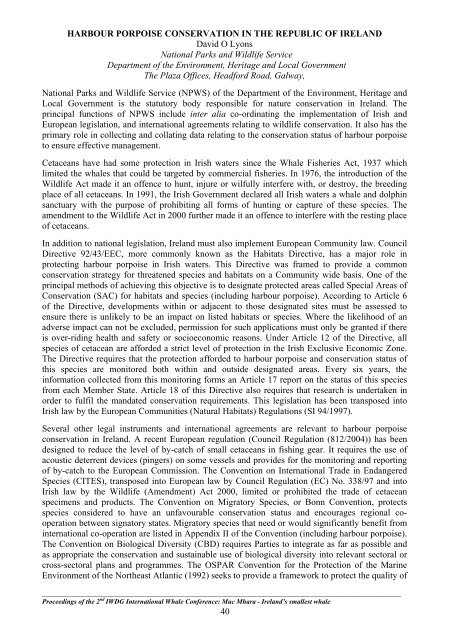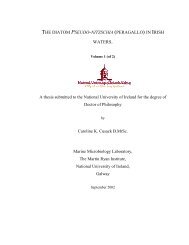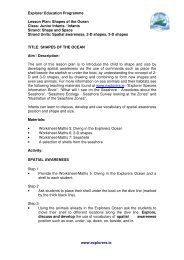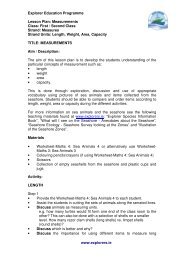Muc Mhara Ireland's Smallest Whale - Marine Institute Open Access ...
Muc Mhara Ireland's Smallest Whale - Marine Institute Open Access ...
Muc Mhara Ireland's Smallest Whale - Marine Institute Open Access ...
You also want an ePaper? Increase the reach of your titles
YUMPU automatically turns print PDFs into web optimized ePapers that Google loves.
HARBOUR PORPOISE CONSERVATION IN THE REPUBLIC OF IRELAND<br />
David O Lyons<br />
National Parks and Wildlife Service<br />
Department of the Environment, Heritage and Local Government<br />
The Plaza Offices, Headford Road, Galway,<br />
National Parks and Wildlife Service (NPWS) of the Department of the Environment, Heritage and<br />
Local Government is the statutory body responsible for nature conservation in Ireland. The<br />
principal functions of NPWS include inter alia co-ordinating the implementation of Irish and<br />
European legislation, and international agreements relating to wildlife conservation. It also has the<br />
primary role in collecting and collating data relating to the conservation status of harbour porpoise<br />
to ensure effective management.<br />
Cetaceans have had some protection in Irish waters since the <strong>Whale</strong> Fisheries Act, 1937 which<br />
limited the whales that could be targeted by commercial fisheries. In 1976, the introduction of the<br />
Wildlife Act made it an offence to hunt, injure or wilfully interfere with, or destroy, the breeding<br />
place of all cetaceans. In 1991, the Irish Government declared all Irish waters a whale and dolphin<br />
sanctuary with the purpose of prohibiting all forms of hunting or capture of these species. The<br />
amendment to the Wildlife Act in 2000 further made it an offence to interfere with the resting place<br />
of cetaceans.<br />
In addition to national legislation, Ireland must also implement European Community law. Council<br />
Directive 92/43/EEC, more commonly known as the Habitats Directive, has a major role in<br />
protecting harbour porpoise in Irish waters. This Directive was framed to provide a common<br />
conservation strategy for threatened species and habitats on a Community wide basis. One of the<br />
principal methods of achieving this objective is to designate protected areas called Special Areas of<br />
Conservation (SAC) for habitats and species (including harbour porpoise). According to Article 6<br />
of the Directive, developments within or adjacent to those designated sites must be assessed to<br />
ensure there is unlikely to be an impact on listed habitats or species. Where the likelihood of an<br />
adverse impact can not be excluded, permission for such applications must only be granted if there<br />
is over-riding health and safety or socioeconomic reasons. Under Article 12 of the Directive, all<br />
species of cetacean are afforded a strict level of protection in the Irish Exclusive Economic Zone.<br />
The Directive requires that the protection afforded to harbour porpoise and conservation status of<br />
this species are monitored both within and outside designated areas. Every six years, the<br />
information collected from this monitoring forms an Article 17 report on the status of this species<br />
from each Member State. Article 18 of this Directive also requires that research is undertaken in<br />
order to fulfil the mandated conservation requirements. This legislation has been transposed into<br />
Irish law by the European Communities (Natural Habitats) Regulations (SI 94/1997).<br />
Several other legal instruments and international agreements are relevant to harbour porpoise<br />
conservation in Ireland. A recent European regulation (Council Regulation (812/2004)) has been<br />
designed to reduce the level of by-catch of small cetaceans in fishing gear. It requires the use of<br />
acoustic deterrent devices (pingers) on some vessels and provides for the monitoring and reporting<br />
of by-catch to the European Commission. The Convention on International Trade in Endangered<br />
Species (CITES), transposed into European law by Council Regulation (EC) No. 338/97 and into<br />
Irish law by the Wildlife (Amendment) Act 2000, limited or prohibited the trade of cetacean<br />
specimens and products. The Convention on Migratory Species, or Bonn Convention, protects<br />
species considered to have an unfavourable conservation status and encourages regional cooperation<br />
between signatory states. Migratory species that need or would significantly benefit from<br />
international co-operation are listed in Appendix II of the Convention (including harbour porpoise).<br />
The Convention on Biological Diversity (CBD) requires Parties to integrate as far as possible and<br />
as appropriate the conservation and sustainable use of biological diversity into relevant sectoral or<br />
cross-sectoral plans and programmes. The OSPAR Convention for the Protection of the <strong>Marine</strong><br />
Environment of the Northeast Atlantic (1992) seeks to provide a framework to protect the quality of<br />
_________________________________________________________________________________________________________<br />
Proceedings of the 2 nd IWDG International <strong>Whale</strong> Conference: <strong>Muc</strong> <strong>Mhara</strong> - Ireland’s smallest whale<br />
40





